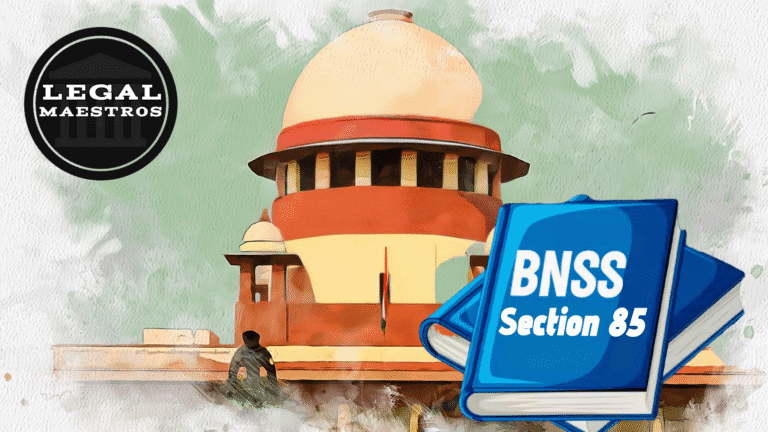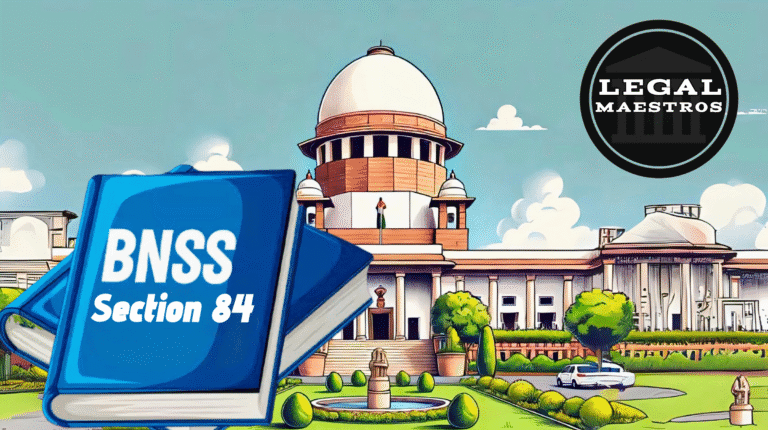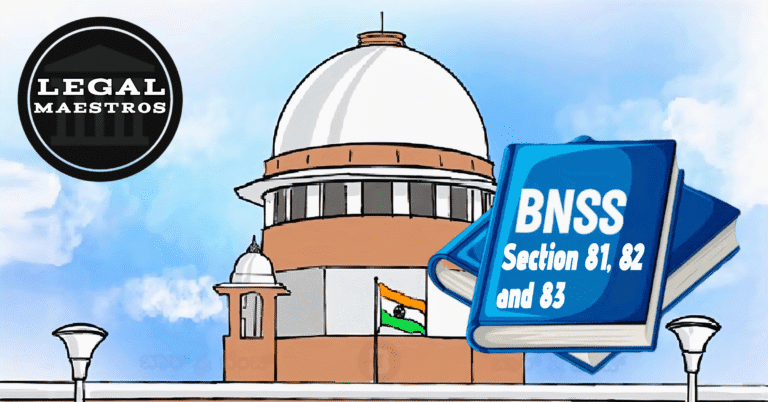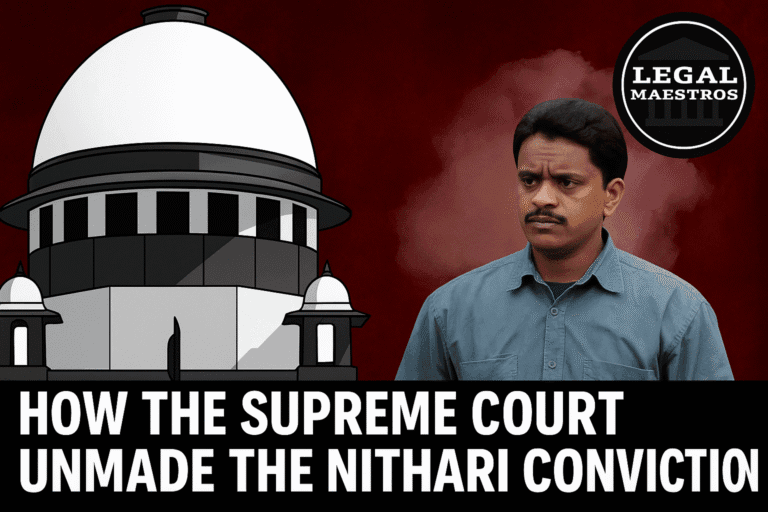
Section 44: Search of Place Entered by Person Sought to Be Arrested
The authority to search premises is granted to law enforcement personnel under Section 44 in the event that they have reason to believe that the individual who is to be detained is hiding inside.
Demand for Entry and Obligation to Cooperate are both included in the first subsection.
The right to demand entrance into a particular house or location is granted to a law enforcement officer or any other person who is in possession of a valid arrest warrant and who has reason to believe that a person who is to be arrested is present in that house or location. In addition to assisting with the search, the person in charge of the residence or any occupant is required to grant permission for the police to enter the house. If you comply with this demand, you are under a legal responsibility to do so.
Consider the following scenario: a law enforcement officer has a warrant to arrest a guy named Ravi, and they have reason to think that Ravi is hiding out at the residence of his friend. A demand for entrance is made by the officer when he approaches the residence. To assist in the search for Ravi, the friend is required to get permission for the police to enter.
For any queries or to publish an article or post or advertisement on our platform, do call at +91 6377460764 or email us at contact@legalmaestros.com.
If access is denied, the second subsection allows for forced entry.
The legislation permits the police to smash open doors or windows in order to obtain entry into the building in the event that the officer is denied entry and the warrant cannot be executed without putting the accused person in danger of escaping. Not only does this include the residence of the accused person, but it also encompasses any other location where the individual is thought to be hiding. Prior to carrying out this action, the officer is required to:
It is important to inform the occupants about his authority and the reason for his entry.
To be admitted, you must submit a formal request.
For any queries or to publish an article or post or advertisement on our platform, do call at +91 6377460764 or email us at contact@legalmaestros.com.
Even if admission is still denied, the officer will only be able to enter the building by force.
Particular Provisions Regarding Women In the event that the location to be accessed is a private area that is occupied by a woman who, as a result of custom, does not appear in public (for example, when she is in purdah), the officer is required to inform the woman and provide her with the opportunity to depart the room or area before entering. In order to withdraw, the officer is obligated to ensure that she has sufficient time and privacy. As soon as this occurs, the officer will be able to enter the premises.
In the event that the officer suspects that the accused is hiding in a house where the inner room is occupied by a woman who is adhering to traditional practices, the officer is required to voice their suspicions and allow the woman sufficient opportunity to relocate to another room. The officer is only allowed to enter, even if it is with force, after ascertaining that she has withdrawn.
For any queries or to publish an article or post or advertisement on our platform, do call at +91 6377460764 or email us at contact@legalmaestros.com.
To break doors in order to escape or rescue other people is the third subsection.
An officer or other person authorized to conduct an arrest is permitted by this section of Section 44 to smash open any door or window in order to not only arrest someone but also to liberate himself or another person who is trapped or forcibly held within a location after lawfully accessing there.
Consider the following scenario: a law enforcement officer enters a building in order to secure the arrest of a person. The officer is locked inside the building by the accused and his accomplices after they have entered. Legally speaking, the cop is permitted to smash open the door or window in order to escape, or he may call for assistance from other individuals in order to break in and rescue him.
Section 45: Pursuit of Offenders into Other Jurisdictions
There is a provision in Section 45 that gives law enforcement personnel the authority to pursue and apprehend criminals even if they reach another jurisdiction within India. This section works to ensure that law enforcement is carried out without interruption across state and territorial boundaries.
For any queries or to publish an article or post or advertisement on our platform, do call at +91 6377460764 or email us at contact@legalmaestros.com.
Unrestricted Rights to Pursue Across India
It is not necessary for a police officer to get a new warrant or special permission in order to pursue and arrest a person who has fled to another state or region in India. It is possible for the pursuit to take place quickly, and the officer retains complete authority to apprehend the accused even if they are located outside of the officer’s ordinary territorial jurisdiction.
For example, if a person commits a theft in Delhi and then escapes to Punjab, the officer from the Delhi Police Department who is authorized to arrest the offender can travel to Punjab and make the arrest without first obtaining authorization from the authorities in Punjab. This guarantees that there will be no delays that could allow the criminal to evade arrest and prosecution.
Meaning and Importance of This Provision
The importance of this part cannot be overstated in a country as large as India, where migration between states is commonplace. If such a clause did not exist, criminals would be able to circumvent arrest by taking advantage of jurisdictional boundaries. The continuous operation of law enforcement is ensured by Section 45, which eliminates any superfluous administrative obstacles.
For any queries or to publish an article or post or advertisement on our platform, do call at +91 6377460764 or email us at contact@legalmaestros.com.
Section 46: No unnecessary restraint.
If a person is being arrested, the police officer is only allowed to employ as much physical restraint as is absolutely necessary to prevent the person from escaping. This is because Section 46 ensures that this is the case. Maintaining the dignity and rights of persons is the guiding principle in this situation, even when those individuals are suspected of committing a crime.
With Restricted Use of Force
The individual who has been detained should not be tied, shackled, or treated violently unless it is absolutely necessary to prevent the person from escaping or being harmed. Handcuffs and other forms of physical restraint should be used in a manner that is appropriate to the risk that the accused person poses.
In the event where an individual willingly consents to come to the police station and is working with the officer, the officer is not permitted to handcuff or drag the individual without a reasonable reason. With that being said, the use of handcuffs or a higher degree of constraint may be warranted in the event that the individual in question is violent or has a history of fleeing.
For any queries or to publish an article or post or advertisement on our platform, do call at +91 6377460764 or email us at contact@legalmaestros.com.
With due regard for human rights
This particular portion demonstrates the significance of human rights even in the context of legal proceedings. Because of this, it ensures that individuals are not humiliated or subjected to undue force simply because they are being detained.
Regulatory Protections and Personal Responsibility
The use of any form of constraint by law enforcement officials during an arrest must be justified. Any use of force that is seen to be excessive or unnecessary may result in disciplinary or legal action being taken against the officer who was involved. Because of this provision, accountability is established, and the abuse of power is discouraged.






![Research Assistantship @ Sahibnoor Singh Sindhu, [Remote; Stipend of Rs. 7.5k; Dec 2025 & Jan 2026]: Apply by Nov 14, 2025!](https://legalmaestros.com/wp-content/uploads/2025/11/Gemini_Generated_Image_s0k4u6s0k4u6s0k4-768x707.png)
![Karanjawala & Co Hiring Freshers for Legal Counsel [Immediate Joining; Full Time Position in Delhi]: Apply Now!](https://legalmaestros.com/wp-content/uploads/2025/11/Gemini_Generated_Image_52f8mg52f8mg52f8-768x711.png)
1 thought on “Sections 44, 45, and 46 of Bharatiya Nagarik Suraksha Sanhita, 2023: Guidelines on Search, Pursuit, and Arrest”